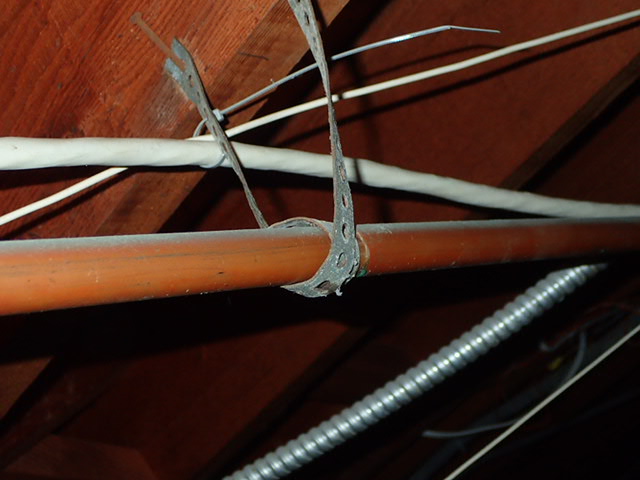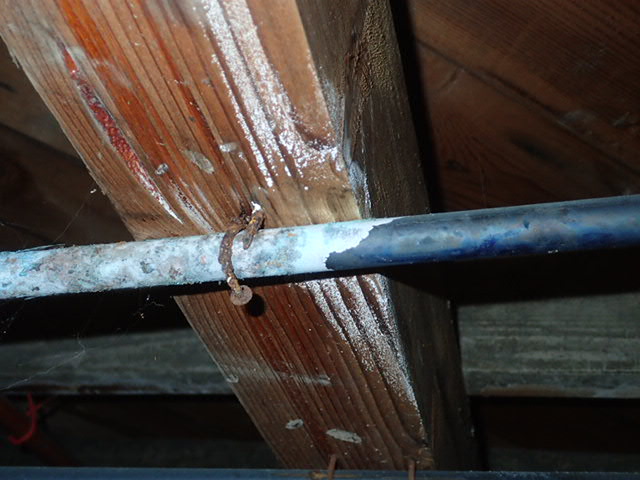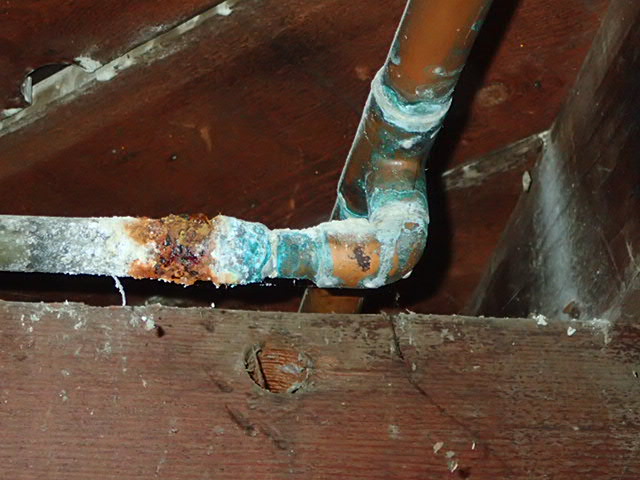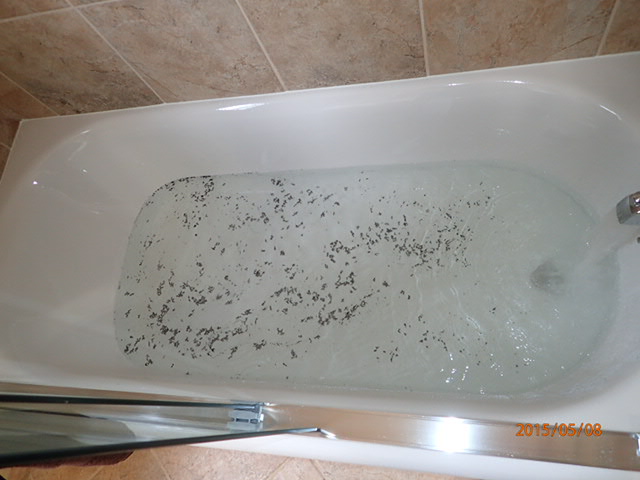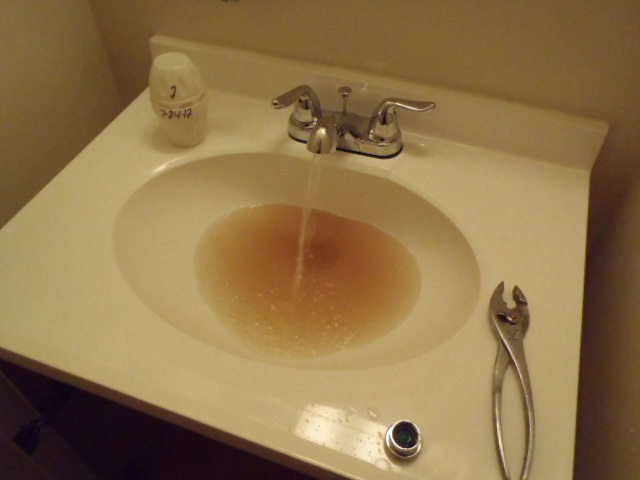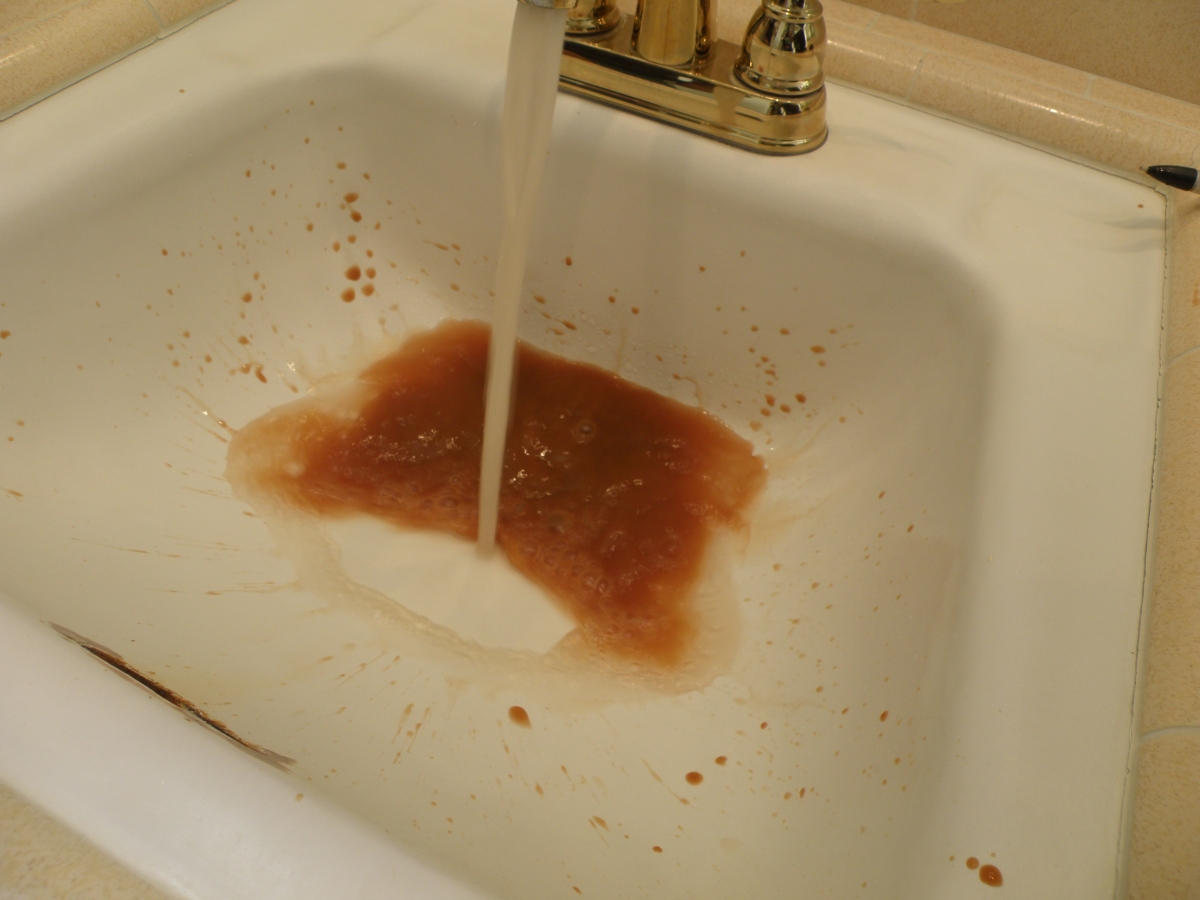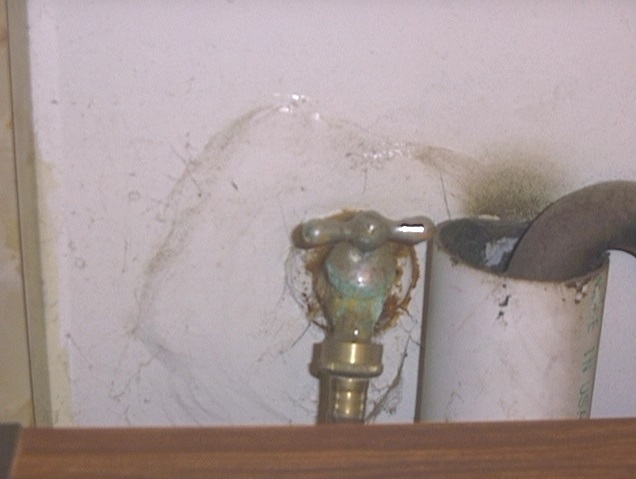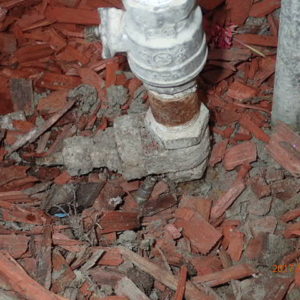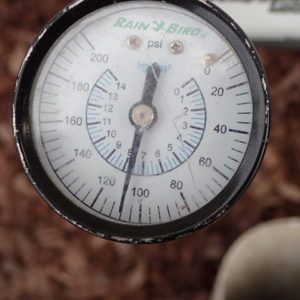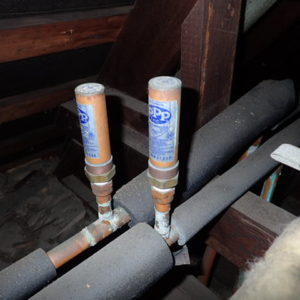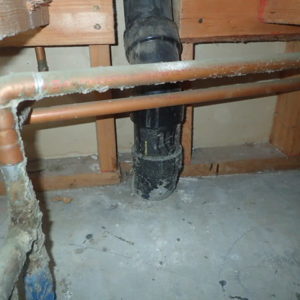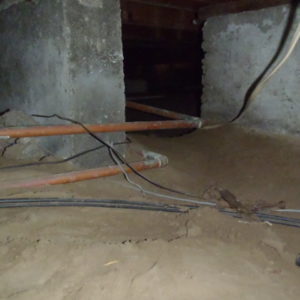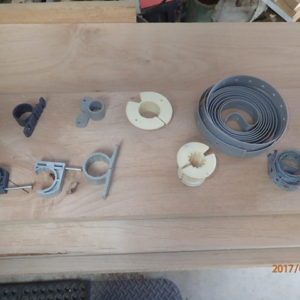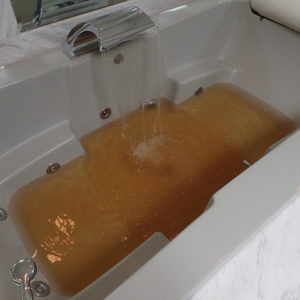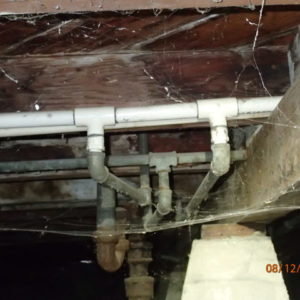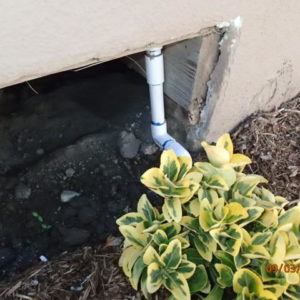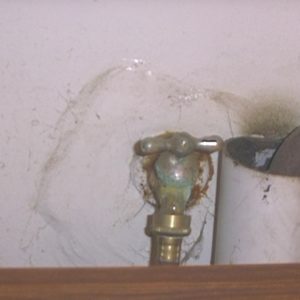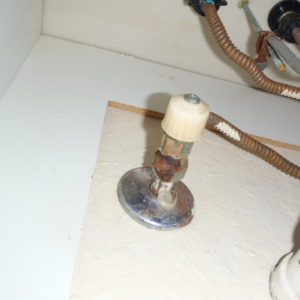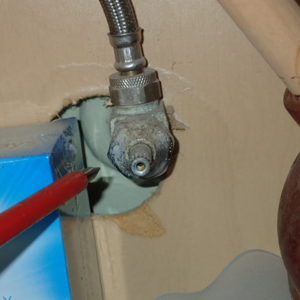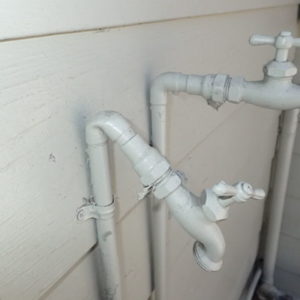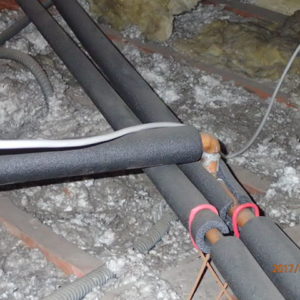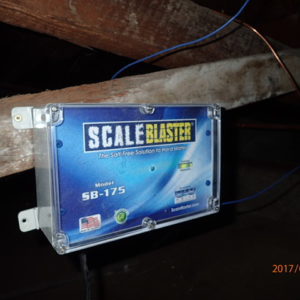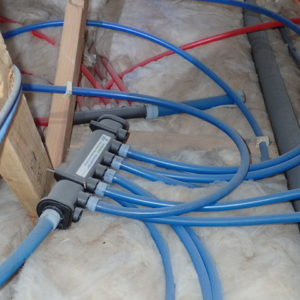Steel, copper, Aquapex or what the heck is that garden hose doing under the sink? There are several products that have been used to provide a fresh water supply to the structure. All of them start off without leaks. Everything will someday develop leaks. Don’t fight it or yell, simply be aware and monitor materials to prevent water from leaking. You have to service your car’s oil and I have never planned a flat tire, but these things happen. We just want to minimize the pain when something goes wrong.
Galvanized steel lines have been used for over a century. If you think you have a house before 1900 and may have pipes sweated together with lead, why are you wasting your time reading this? None of us will look our best or function the same after 100 years so replace it before leaks occur. You already have a classic house, don’t let water ruin anything.
Steel lines were electroplated with a zinc coating giving it a silvery color. We all know that steel rusts. Raw steel oxidizes and rusts quickly. This accelerates and continues to corrode through the steel that even has thick walls. So the plating did provide 30, 40 or more years of usage without much detrimental effect on water flow. As the plating eventually flakes and peels exposing the raw steel inside or outside the pipe, that area will rust. If you see any pipe that is rusty on the outside, it is worse on the inside! Similar to the clogging of arteries, corrosion and rust build-up inside a supply line can also reduce the flow through that line. Have you ever had someone ask you not to use the water when they shower so you do not burn them? You know what is meant by that.
Partial re-piping a house can certainly help but may have limited improvements. First there is the main line from the City. Often this will be a meter box near the street of a property. At the City meter there may be a ¾ or 1 inch fitting. If possible, have your plumber remove the ¾ fitting and install a larger 1 inch connector. You do not have to use more water, but the volume of use at Thanksgiving gatherings may be the only time in the year that many things may be turned on at once, so why restrict your main line? Money is the choice as larger pipes cost more so it is truly your choice.
Replacing the main inlet pipe from the City street to your flowerbed can replace 20 or 40 feet of buried pipe that has corroded over the years. Doing this first will provide a healthy flow to the house and almost always makes a difference in older houses first built with steel pipes.
Copper has definitely been around for thousands of years. The ability to extrude molten copper into tubes has been around a little less time than that. No matter what I write about copper being durable, etc., etc., you have heard horror stories of slab leaks and the damage that has occurred at a friends or some famous movie star belly-aching on TV. There is no denying that when humans are involved and we are not in the perfect Heaven, there will be plumbing leaks.
A short story is that virgin material comes from ore. It can be made into six different tempers (hardness) and range from soft sheets for decorative things going up in hardness to electrical and plumbing, etc. and for specific applications. The really long story would include that not every country feels like they have to go along with “Associations” in the United States for uniformity and quality control throughout the industry. And getting right to the point, the U.S. sends a lot of scrap material overseas and it comes back at a lower priced product in the BIG BOX supply stores. If you think the wall thickness is the same and that fleck of steel in a copper tube won’t rust, think again. Accidents can and always will happen. Cheapest product is another problem that does not usually bring the best product to market. I will stop at that.
So let’s get back to plumbing in a house. When it comes to main supply lines, I will always counsel a person to install the largest main line that is reasonable. It may cost a little more for the larger pipe, but what changes does the future hold? Any additions, pools or even backyard sprinklers can take more water away from the shower. Do not let a cheap bid put in a 1/2 inch line. Pay for a 1 inch line if you can afford it. Ask what the pipe diameter and “Type” of copper the plumber quoted in the price. I hate to do this, but I have to throw some numbers into this section for those who need clarification. Click on the icons for some hidden notes if you are interested.
In general, the main inlet water line and all distribution supply pipes are primarily described by the interior diameter of the pipe. Only so many gallons of water can get through that main inlet pipe at once. The government studies researched the probability of how many and what fixtures would be used in a house (No kidding, they really had research done) and made some graphs. The graphs show what is the normal GPM (Gallons per minute) of faucets, showers, tubs, etc. They turned that into “Fixture Units”. Once you figure how many “Units” (faucets and toilets in the house), you simply point your finger at the chart and see what size of pipes you should have. “Should Have” is pretty ambiguous depending upon if you are single and live alone in a 5000 sq ft. house with 6 bathrooms or trying to measure for a 2 bedroom 1 bath home with Mom and Dad plus three kids in the other bedroom with a lot of gallons each day when it is bath time.
Up to three 3/8-inch branches can be served by a 1/2-inch main.
Up to three 1/2-inch branches can be served by a 3/4-inch main.
Up to three 3/4-inch branches can be served by a 1-inch main.
The sizing of more complex distribution systems requires detailed analysis of each of the sizing design considerations listed above. Believe it or not, once you are done with the supply line calculations, you are supposed to match them up with the drain lines in that area of the house, etc.
Steel, copper or plastic, all supply water lines have to be properly supported. When in the crawlspace or attic, things are supposed to be secured. The minute differences will be how far apart are there supposed to be supports. Steel lines can go further than plastic lines before sagging. There are some designated materials to support the water lines and that can be surprising to many people. You cannot have steel touching copper lines in any form as it will cause corrosion. There are plastic holders, plastic-coated steel holders, etc. that will not cause problems.
If the supply lines are not properly secured you can sometimes get “banging” sounds. Now how would that happen? If you have 60 pounds of pressure at the front main valve from the City pump station, when you open the bathtub valve water flows pretty fast. If you have ever turned off the tub water with a quick turn of the wrist, you sometimes might hear the pipes make noise. It is as if the water was flowing at 60 MPH (not really but this is an analogy) and you instantly closed the valve. This caused all the rushing water to panic stop and the pipes move, kind of bounce, when all that inertia and pressure instantly comes to a halt. Most of the time we move smoothly to turn on hose bibs and faucets, but you may have your hands full and slap at the kitchen lever to turn off the water and hear the pipes band. Pipes in the attic, walls and crawlspace are supposed to be secured and isolated to prevent this noise. This doesn’t mean you will die from the sound, it will only be irritating.
Misc. Plumbing
Many a household has what is known as a water softener. There are methods that have been used for decades to...










